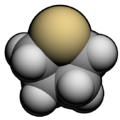Tetrahydrothiophene
Chemical compound From Wikipedia, the free encyclopedia
Tetrahydrothiophene is an organosulfur compound with the formula (CH2)4S. The molecule consists of a five-membered saturated ring with four methylene groups and a sulfur atom. It is the saturated analog of thiophene and is therefore the sulfur analog of THF. It is a volatile, colorless liquid with an intensely unpleasant odor. It is also known as thiophane, thiolane, or THT.
| |||
| Names | |||
|---|---|---|---|
| Preferred IUPAC name
Thiolane | |||
| Other names
Tetrahydrothiophene, thiophane, tetramethylene sulfide | |||
| Identifiers | |||
3D model (JSmol) |
|||
| Abbreviations | THT | ||
| 102392 | |||
| ChEBI | |||
| ChEMBL | |||
| ChemSpider | |||
| ECHA InfoCard | 100.003.391 | ||
| EC Number |
| ||
PubChem CID |
|||
| RTECS number |
| ||
| UNII | |||
| UN number | 2412 | ||
CompTox Dashboard (EPA) |
|||
| |||
| |||
| Properties | |||
| C4H8S | |||
| Molar mass | 88.17 g·mol−1 | ||
| Appearance | colorless liquid | ||
| Density | 0.997 g/mL[1] | ||
| Melting point | −96 °C (−141 °F; 177 K) | ||
| Boiling point | 119 °C (246 °F; 392 K) | ||
| Hazards | |||
| Occupational safety and health (OHS/OSH): | |||
Main hazards |
Stench, flammable, irritant | ||
| GHS labelling: | |||
  | |||
| Danger | |||
| H225, H302, H312, H315, H319, H332, H412 | |||
| P210, P233, P240, P241, P242, P243, P261, P264, P270, P271, P273, P280, P301+P312, P302+P352, P303+P361+P353, P304+P312, P304+P340, P305+P351+P338, P312, P321, P322, P330, P332+P313, P337+P313, P362, P363, P370+P378, P403+P235, P501 | |||
| Flash point | 12 °C (54 °F; 285 K) | ||
| 200 °C (392 °F; 473 K) | |||
| Safety data sheet (SDS) | Oakwood | ||
| Related compounds | |||
Related compounds |
Tetrahydrofuran, Thiophene, Selenolane, Thiazolidine, Dithiolane, Thiane | ||
Except where otherwise noted, data are given for materials in their standard state (at 25 °C [77 °F], 100 kPa).
| |||
Synthesis and reactions
Tetrahydrothiophene is prepared by the reaction of tetrahydrofuran with hydrogen sulfide. This vapor-phase reaction is catalyzed by alumina and other heterogenous acid catalysts.[2][3]
This compound is a ligand in coordination chemistry, an example being the complex chloro(tetrahydrothiophene)gold(I).[4]
Oxidation of THT gives the sulfone sulfolane, which is of interest as a polar, odorless solvent:
- C4H8S + 2 O → C4H8SO2
Sulfolane is, however, more conventionally prepared from butadiene.
Natural occurrence
Both unsubstituted and substituted tetrahydrothiophenes are reported to occur in nature. For example, tetrahydrothiophene occurs as a volatile from Eruca sativa Mill. (salad rocket)[5] while monocyclic substituted tetrahydrothiophenes have been isolated from Allium fistulosum 'Kujou',[6] Allium sativum (garlic),[7] Allium cepa (onion),[8] Allium schoenoprasum (chives),[9] and Salacia prinoides.[10] Albomycins are a group of tetrahydrothiophene-ring containing antibiotics from streptomyces while biotin and neothiobinupharidine (and other nuphar alkaloids [11]), are examples of bicyclic and polycyclic tetrahydrothiophene-ring containing natural products, respectively.
Applications
Because of its smell, tetrahydrothiophene has been used as an odorant in LPG,[3] albeit no longer in North America. It is also used as an odorant for natural gas, usually in mixtures containing tert-butylthiol.
Tetrahydrothiophene is a Lewis base classified as a soft base and its donor properties are discussed in the ECW model.
See also
References
Wikiwand - on
Seamless Wikipedia browsing. On steroids.

